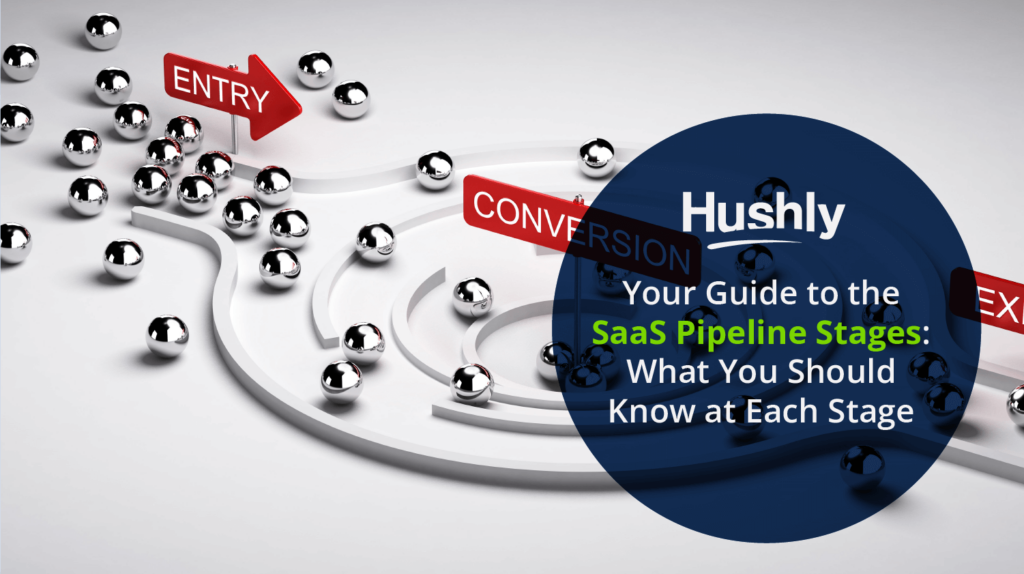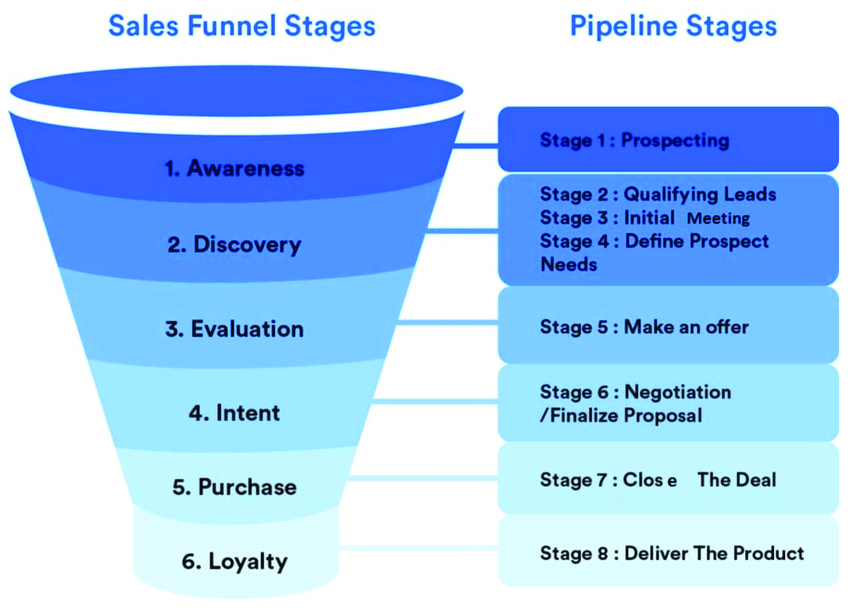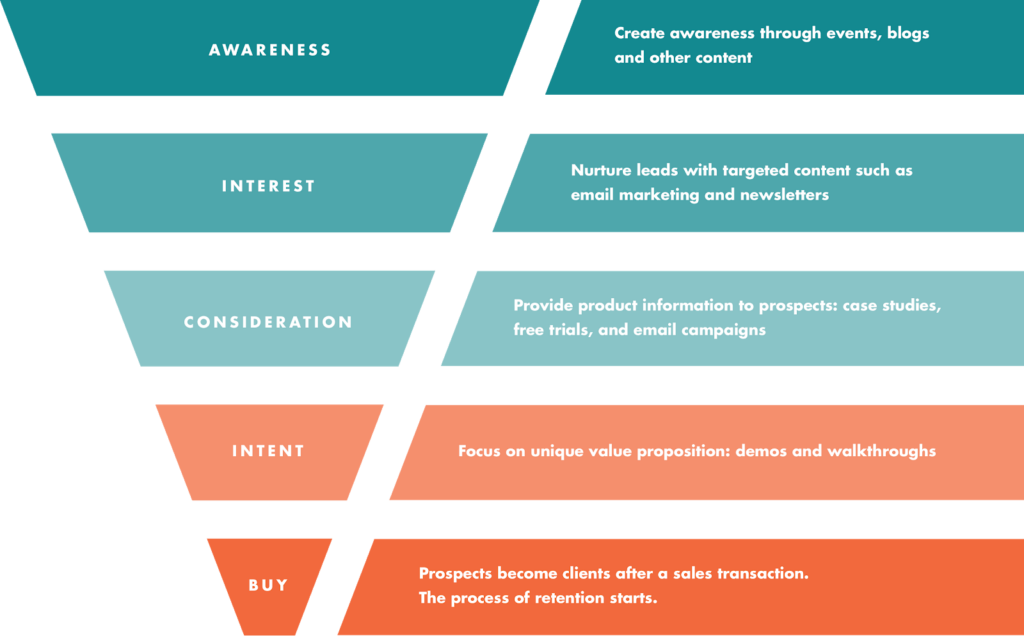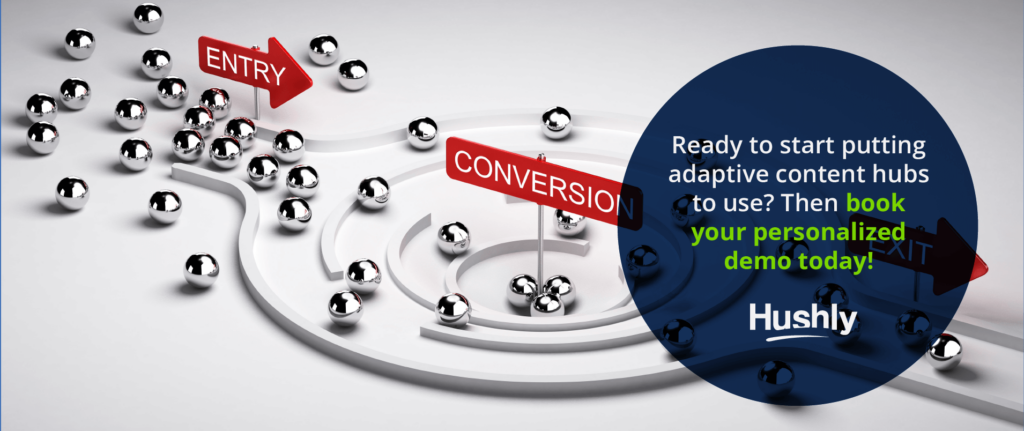The SaaS sales funnel is a highly complex, multi-stage process. To make the most of your conversion optimization process, it’s crucial to understand SaaS pipeline stages and the common traits of each stage. Armed with this knowledge, you’ll be better prepared to make the most of your efforts and increase the likelihood of a successful close.

Sales Funnel vs. Sales Pipeline
Sales funnel and sales pipeline are two different things. Sometimes they overlap, but they’re not the same thing.
The sales funnel is a marketing concept that describes the process a visitor takes from first discovering your brand to becoming a customer.
On the other hand, the sales pipeline is a sales concept that refers to the process a salesperson takes to move a lead through the sales process and into a sale.
Both the sales funnel and sales pipeline are processes that occur on a continuum, with no clear beginning or end – despite their funnel shape, which is why many now avoid using the term “funnel” and instead use the phrasing “cycle.”

Source: ResearchGate
The SaaS Sales Pipeline: What Is It?
The SaaS sales pipeline is a series of stages through which a lead progresses from the initial discovery of your brand to closing a deal by taking a desired action. The goal of each stage is to progressively increase the lead’s level of interest and commitment until they’re ready to move forward to the next step in the process.
The SaaS pipeline stages are often broken down into six to eight stages, with each subsequent stage building on the knowledge and skills learned in the prior one.
How a SaaS Sales Pipeline Works
The SaaS sales pipeline is designed to maximize the number of sales-ready leads and minimize the amount of time spent closing sales that aren’t a good fit.
The SaaS sales pipeline is a continuous process, not a one-time event. Sales reps must be prepared to adjust tactics, processes, and strategies as leads progress through the pipeline.
SaaS Pipeline Stages: Utilizing Your Content to Propel Leads Forward
If you’re a B2B marketer, you know that content is the lifeline of your business. You are responsible for creating high-quality, informative content that helps customers solve their problems.
Unfortunately, creating content isn’t enough. It must be strategically distributed by your marketing and sales team to ensure maximum exposure. It needs to be optimized to capture and propel leads forward through the SaaS pipeline.
The key to a successful SaaS marketing and sales campaign is to understand the purpose and role of each stage in the SaaS sales pipeline and to tailor your content to meet the needs of each stage.

Source: Moz
Let’s break it down based on one of the most frequently utilized SaaS pipeline models:
Prospecting
This is the first stage in the SaaS sales pipeline and is characterized by the discovery of your brand by a potential lead. At this stage, a lead is just exploring their options and is typically unaware of your brand or what it offers. Even if they’ve heard of you, they may not be ready to take action in the form of a purchase or contact.
This stage requires a lot of brand awareness and education on your part to generate qualified leads. The key to success at this stage is to create high-quality, relevant content that answers your customers’ questions and addresses their needs and frustrations.
You also need to be prepared to participate in all the major marketing channels, starting with organic and paid search, social, and content marketing.
Lead/Account Qualification
The second stage in the SaaS sales pipeline is lead/account qualification. At this stage, a lead has become aware of your brand and is starting to explore what you have to offer. They’re beginning to learn about your company culture, your products and services, and the people behind them.
They’re also beginning to move beyond awareness and education and into the consideration phase. They’re starting to ask questions, look into pricing and scheduling, and do some research to better understand what you do and why they should choose you.
This is a critical stage in the SaaS sales pipeline. At this stage, you’ll need to be prepared to share your value proposition, explain the benefits of your product or service using case studies, testimonials, and success stories, and demonstrate the results your customers are achieving.
Demo/Meeting
This is the third stage in the SaaS sales pipeline and is characterized by the opportunity for a face-to-face meeting or demo of your product or service.
At this stage, a lead has started to form a preliminary opinion of your brand and is starting to get a sense of whether they would like to pursue a deeper relationship or not.
The key to success at this stage is to be prepared to go beyond sales pitches and presentations and connect with your leads on a personal level. This can be accomplished through in-person meetings, phone calls, and video demos.
Proposal
The fourth stage in the SaaS sales pipeline is the proposal. This is the culmination of the relationship that has been building over the course of several interactions.
At this stage, a lead has formed a favorable opinion of your brand, clearly understands what you offer, and is ready to move into a contract phase.
Content that could prove beneficial at this stage includes pricing information, product or service overviews to help you continue building rapport and trust and other materials that help you educate your potential customers and build anticipation for the next stage in the relationship.
Negotiation and Commitment
The fifth and final stage in the SaaS sales pipeline is negotiation and commitment. This is the point in the relationship where a sale is almost complete, a contract is being signed, and money is being exchanged.
While it may seem like the end of the journey – that couldn’t be further from the truth. The SaaS sales pipeline is a continual process of building and strengthening your relationship with the lead/account.
You’ll want to make sure you are nurturing the relationship by providing value, answering questions, and providing additional education and information as needed to ensure your new account has what they need to get started.
Opportunity Won
At this point, you’ve won the opportunity. You’ve demonstrated your value, built a relationship, and earned the trust and commitment of your lead. This is the point where you can move into the delivery and implementation phase of the SaaS sales pipeline. You’ll want to take this opportunity to ensure you’re prepared to meet the needs of your new account and continue building value that will help you secure a long-term relationship.
Post-Purchase
The final SaaS pipeline stage is the post-purchase stage. This is the point in the relationship where you’ve delivered on promises, helped your customer solve their problems, and are delivering value.
The most important thing you can do at this stage is to ensure you’re providing the right level of ongoing support, so you’re able to continue building a strong relationship with your new customer. This will allow you to transition into the SaaS sales pipeline’s retention and referral marketing phases.
Make the Most of Your Funnel Optimization with Hushly’s Adaptive Content Hub
Hushly’s adaptive content hubs let you create the perfect experience for each stage of the SaaS sales pipeline. With just a few clicks, you can design a content experience that is targeted, relevant, and helps you build trust and rapport. This will help you make the most of every moment with your leads.
Ready to start putting adaptive content hubs to use? Then book your personalized demo today!

